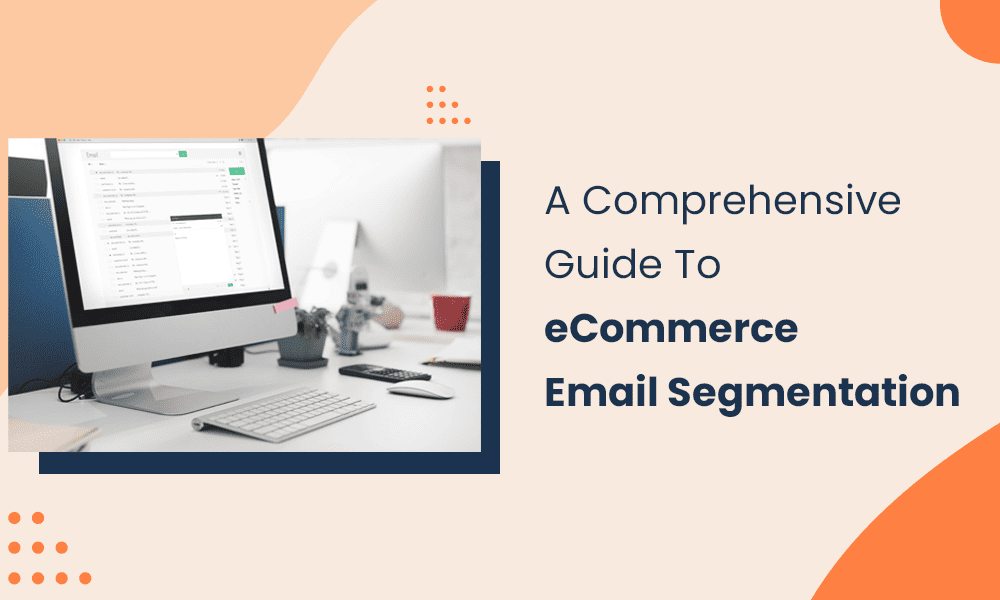Every email subscriber prefers customized email marketing experiences because they’re unique and more relevant. This is why personalized emails perform better than regular emails. But while personalization creates pleasant customer experiences, it is not possible without a clear email segmentation strategy.
In eCommerce, email segmentation helps you tailor the right content and offers to the ideal recipients using pre-defined criteria.
This article is a beginner’s guide to eCommerce email segmentation. And as you read on, you will learn the various categories of email segments, effective segmentation strategies, common mistakes to avoid, and some frequently asked questions.
But you cannot understand all of these if you don’t know the concept of email segmentation. So, let’s start with the basics.
Table of Contents
What is Email Segmentation?
Email segmentation is a marketing technique that allows you to split your subscribers into smaller targeted groups (segments) based on pre-defined attributes or criteria. Generally, your audience comprises individuals with diverse interests and preferences, so it’s essential to create custom and personalized emails that target each customer’s needs and pain points.
An effective personalization strategy thrives on excellent segmentation. And no matter how valuable your emails are, they become irrelevant once they land in the inbox of the wrong audience segment. So, smart segmentation entails placing your users in distinct groups and sending customized offers that speak directly to them.
Why Is Email Segmentation Important?
Segmentation is a key component of your eCommerce email marketing strategy. It helps you run successful marketing campaigns with customized content tailored to the right recipients. Here are four major benefits of email list segmentation in eCommerce.
1. Enhances personalization
Email segmentation answers the question: “Who should I send this email to?”, while email personalization answers the question: “What should I send?”
In email segmentation, you identify a group of subscribers with similar attributes or characteristics. This process enables you to craft tailored content or offers that appeal to a particular segment. So, without proper segmentation, you may not know who needs your message – even if you have something to offer.
For example, if you have a segmented list with Apple and Android users, you can easily create personalized content relevant to each segment.
Read also: Crafting the Perfect Mobile-Friendly eCommerce Email Design: [Tips + Examples]
2. Reduces unsubscribes and spamming
Let’s assume you have an email list with four segments A, B, C, & D, and you send two emails per week to each of these segments. Ideally, you’re pushing out eight emails from your end but your subscribers receive two emails each because they’re properly segmented.
Without a segmented list, your contacts will receive all eight emails in one week and six of which will most likely be irrelevant. Subscribers who receive your emails at this rate may either mark them as spam or unsubscribe from receiving future emails.
So, proper segmentation restricts your offers to only customers who need them.
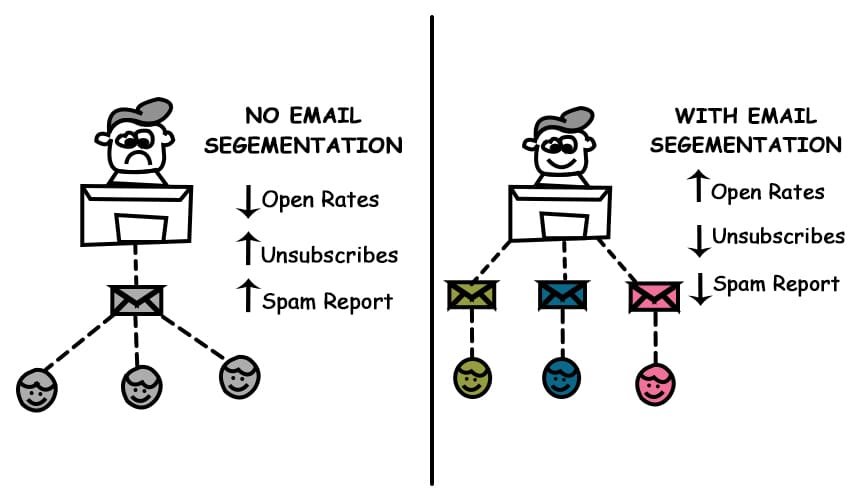
3. Builds healthier customer relationships
Reports from Accenture revealed that 91% of customers are more likely to shop with brands that recognize, remember, and promote relevant offers and recommendations.
An effective segmentation strategy helps you understand your customers better, thus allowing you to send relevant emails that appeal to them personally. This will increase your brand reputation, improve customer satisfaction, and build better customer relationships.
Read also: How AI Is Revolutionizing ECommerce Email Marketing
4. Promotes effective use of marketing resources
Lack of segmentation can harm your ROI. This is because you can spend a huge chunk of your marketing budget promoting a product to the wrong audience. But with proper segmentation, you can reduce unnecessary risks by focusing your resources on data-driven strategies.
This way, you can achieve better results from your efforts.
Read also: Advanced Segmentation Strategies for eCommerce Emails
4 Categories of eCommerce Email Segmentation
Using your customer data, you can define several attributes that will enable you to split your audience into targeted groups. There’s a vast array of basic and advanced email segments that can help you create highly personalized content. However, they all fall under four main categories:
- Demographic segmentation
- Geographic segmentation
- Behavioral segmentation
- Psychographic segmentation
1. Demographic Segmentation
This is the most common form of email segmentation, as it groups your audiences based on descriptive, people-based data such as age, gender, nationality, etc. It lets you target your marketing operations to real people using their personalities and attributes. These attributes include the following:
- Age
- Occupation
- Name
- Marital status
- Income level
- Gender
- Education level
- Family size
- Nationality
- Religion
Usually, you will only require a few of these as many of them may be unnecessary for your business. So, before segmenting your audience demographically, you need to identify what data your business needs and how useful they are.
For example, if you own an online store for sportswear, you may need your customer’s age, gender, name, etc., and not religion, marital status, or education level.
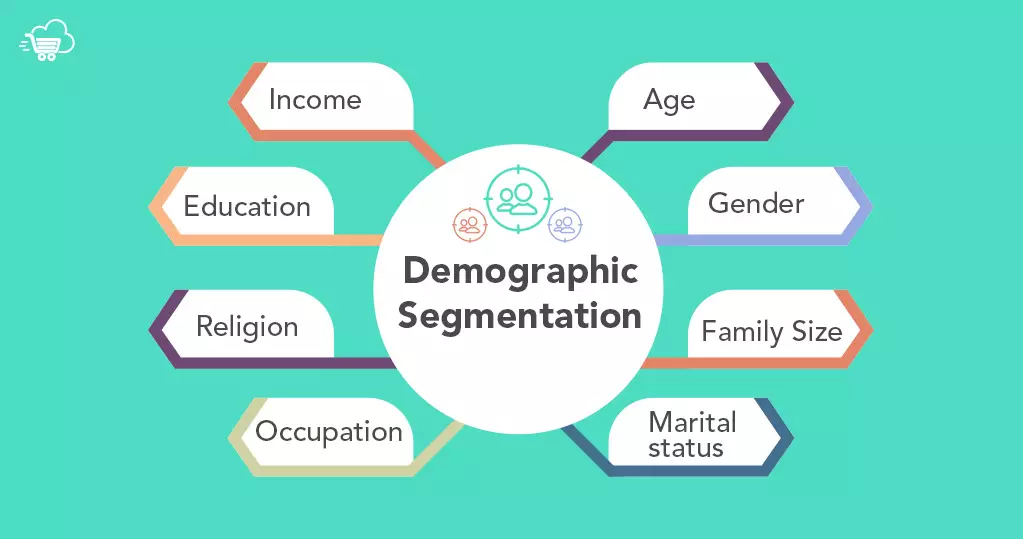
In demographic segmentation, the data is relatively accessible and you can easily collect them through the forms your users fill while registering an account or signing up to your email list.
Read also: eCommerce Product Recommendation Emails You’ll Love
2. Geographic Segmentation
In most cases, this category falls under demographic segmentation. However, it is slightly different, as you group your subscribers based on their location – country, region, state, city, and zip code. This form of segmentation is crucial for businesses that target users in multiple regions because the offers you promote will depend on your customers’ location.
Understanding the population density, climate, culture, and characteristics of a particular location will help you streamline your offers and emails to attract users in that locale. And since there are regional differences in languages, you need to tailor your emails using the right language depending on the location you’re targeting.
For example, the fluffy and light sugar candy is called “candy floss” in the US and “cotton candy” in the UK. So, an online supermarket will take these differences into account while targeting customers in these locations.
Proper segmentation in this category also helps you promote your products in locations where they’re available or can easily be delivered. Even more, it lets you send timely emails based on your recipients’ time zones and when you organize offline events, your email invites will be targeted to users in those locations.
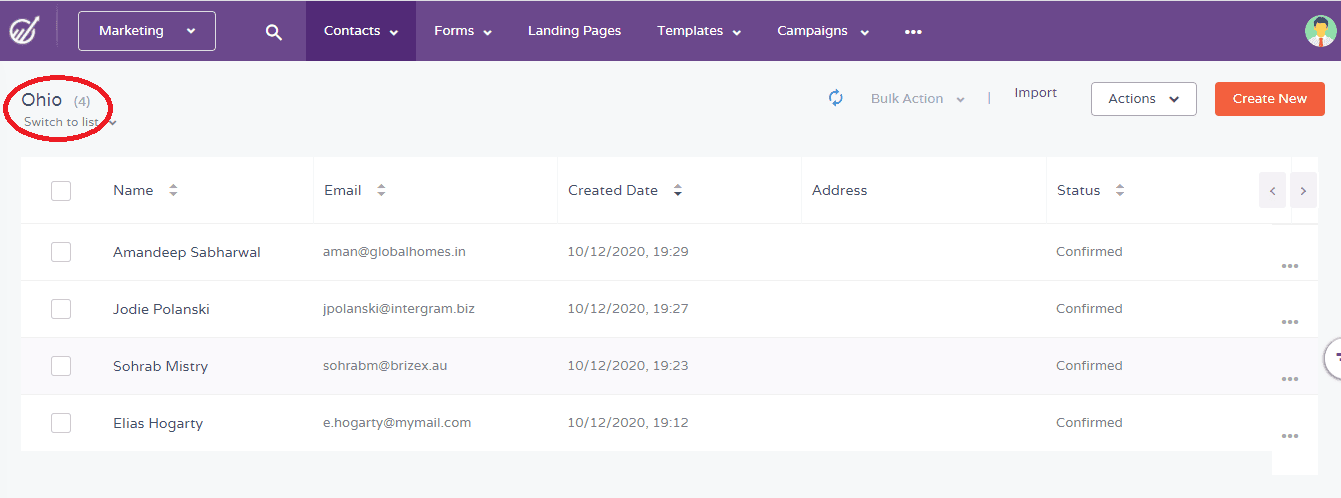
3. Behavioral Segmentation
As the name implies, this form of segmentation splits your audience based on their behavior and interaction with your site. It is the most advanced and dynamic form of segmentation because customers’ needs constantly change and their actions are mostly unpredictable.
This category is further divided into several subsets including:
a. Segmentation by engagement
This is one of the most obvious forms of behavioral segmentation. The segments use attributes from your email engagement stats – email opens, unsubscribes, click-throughs, spam rates, etc.
Monitoring what customers do with your emails enables you to create customized content for retaining active users and winning back inactive subscribers.
b. Segmentation by funnel stage
Your customers could be in one of these stages in your sales funnel:
- Awareness
- Consideration
- Conversion
- Loyalty
- Advocacy
Ideally, your emails should be geared toward moving them down the funnel but this isn’t possible if you don’t know their current position.
For example, when customers in the awareness stage are placed in the conversion stage, they may receive more promotional offers which they’d most likely mark as spam. This is because they have little or no information about your brand.
So, segmenting your email list based on customers’ position in the buying journey will determine if you should send a welcome email or an alert for new arrivals.

c. Segmentation based on customer status
The segments in this sub-category are similar to segmentation by funnel stage. However, this is more targeted as it narrows it down to new, inactive, and loyal customers.
- New customers: This group of customers barely know anything about your brand – they are usually at the awareness and consideration stage in your sales funnel. You can further split them into visitors and first-time buyers.
- Inactive customers: This group of customers may have interacted with your brand or even purchased an item in the past but have been dormant for a while. Knowing the cause of their inactivity can help you identify the best marketing technique for this segment.
You can either choose to win them back with special offers and discounts or remove them from your email list if they no longer wish to continue with your brand. - Loyal customers: This group of customers are repeat buyers. You don’t need to hard sell to these because they know your brand and are willing to recommend it to their friends and family. You can, however, promote VIP programs and special offers to create long-lasting relationships.
d. Segmentation by website activity
Visitors interact with your site in many ways – from viewing a product category to adding items to their carts, marking products as favorites, purchasing products, or even leaving the site without doing anything.
Understanding these segments helps you craft the right emails for a particular action. For example, if customers abandon their shopping carts, you can send in a reminder. When they complete an order, you can send a thank you email. And when they view a product category, you can send product recommendation emails and other special offers.
e. Segmentation based on purchase history
The segments in this sub-category appeal to customers who have purchased an item in the past. It includes product price, items purchased, purchase frequency, recent orders, purchase cycle, interests, etc.
These segments help you predict your customers’ buying behavior, enabling you to create tailored content and offers that will lead to optimized and seamless buying experiences.
f. Segmentation based on device type
If you assume all your customers access your emails via desktop alone, you may be ignoring a majority of the users on other device types like tablets and mobile phones.
According to Litmus, 43% of email opens are on mobile while 19% occur on desktop. So, understanding the various device types your customers are using to access your emails and segmenting them accordingly enables you to send customized and responsive emails.
Read also: Uncovering Insights with Behavioral Market Segmentation
4. Psychographic Segmentation
This is another complex form of email segmentation, as the segments you create are based on attributes – mental and emotional – that directly influence your customers’ buying decisions. Unlike demographic segmentation, this form of segmentation is not easily accessible since your customers have varying interests and preferences – which you cannot detect by mere observation.
Psychographic and behavioral segmentation are complementary, as your customer’s interests and values will determine how they interact with your brand. For example, environmentally conscious customers will be more attracted to eco-friendly products.
Also, low-income customers may abandon their carts once they notice prices on the checkout pages are above their budgets.
Understanding these behavioral patterns can help you place your contacts in specific segments, as you will identify why a user viewed a product category, abandoned their carts, or completed an order.
This enables you to create customized offers that appeal to your audience. You can collect the data by using valuable insights from user behavior and interactions with your site. Additionally, you can create online survey forms or quizzes to let customers share their preferences, likes, and dislikes.
This data improves your personalization, as it can help you identify your users’ hobbies, lifestyles, personality traits, etc.
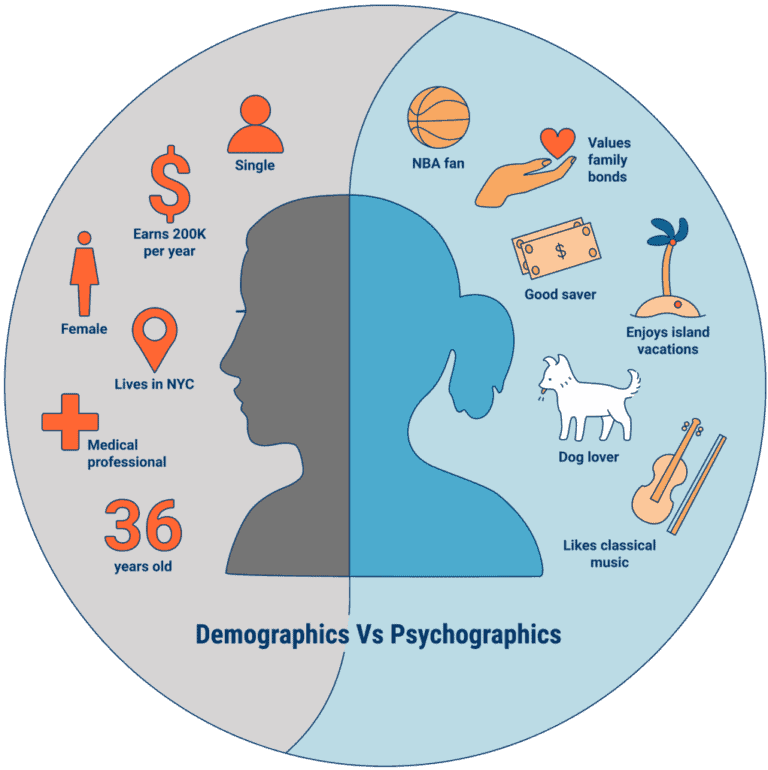
6 eCommerce Email Segmentation Strategies That Work
Audience segmentation is a powerful marketing technique for lasting customer relationships. Let’s look at the strategies that work best in eCommerce email segmentation.
1. Combine multiple segments
Combining multiple segments helps you create master segments for advanced personalization.
For example, Apple users who prefer red color but abandoned their carts will receive a more personalized cart abandoned email with these attributes. However, customers who exclusively belong to one of these segments – Apple users, red color, or cart abandonment – will not receive this email.
Combined segmentation, though complex, improves your email personalization, as you send highly customized content to the right recipients.
However, getting too granular can make things more complicated because you may end up with too many unnecessary segments that are difficult to manage.
So, while you can combine multiple segments, it’s also essential to keep them simple and limited to the necessary groups tailored to meet your business needs.
Read also: The Art of eCommerce Post-Purchase Emails [A Guide]
2. Reward VIP customers
You can create a segment for loyal customers and tailor special offers that motivate them to continue with your brand. Generally, it’s easier to retain an existing customer than it is to acquire a new one.
So, celebrating your loyal or repeat customers makes them feel seen. You can create these segments depending on your business goals. It could be based on engagement rate, purchase frequency, highest-spending customer, etc.
Read also: What Is Audience Segmentation & Its Impact on Marketing
3. Gently reach out to inactive subscribers
Inactive subscribers are gradually leaving your brand, so you may want to go easy on them. Over-promoting your product will only make them unsubscribe or mark you as spam.
You can use several criteria to identify inactive subscribers – recipients who haven’t opened your emails in 30 days, customers who haven’t purchased in 90 days, etc. It all depends on your brand goals and objectives.
In any case, the first approach is to find out the cause of their inactivity – It could be due to a low budget or a change of brand. Understanding this will help you determine if you should let them go or keep in touch with helpful informational content.
Read also: Customer Segmentation Examples & How To Follow Them
4. Spot changes in customer behavior and preferences
Customers’ needs change constantly. A customer that once preferred bright colors may now feel more attracted to darker colors. And users in the US may decide to move over to the UK.
Understanding these changes will help you restructure your segments without impairing your customers’ buying experiences.
For example, if a customer once registered an account in location A but moved to location B six months later, it would be inappropriate to assume the customer’s location before shipping ordered products. This can impair customer experiences, thus reducing your brand reputation.
So, it is necessary to collect vital information that will help you create intelligent email marketing segments.
Read also: 5 eCommerce Email Personalization Strategies [+ Examples]
5. Focus on recipients with high email opens and click-through rate
Customers who read most of your emails are either interested in your brand or enjoy your content.
So, instead of spending marketing resources on visitors who have no interest in your offers, you can tailor your promotional emails to customers who will most likely proceed to check out.
6. Test and refine your segments
Your customers are constantly moving from one segment to another as they interact with your brand or go through the stages of the buyer’s journey. Testing your segments helps you identify if individuals in each segment are growing or reducing.
Are your active customers growing or shrinking? Do you have more or lesser abandoned carts? Data-driven tests help you identify these changes, enabling you to refine your segments to improve future campaigns.
For example, if you notice more customers are viewing a particular product category, you can create a separate segment for them and schedule your emails to promote customized offers.
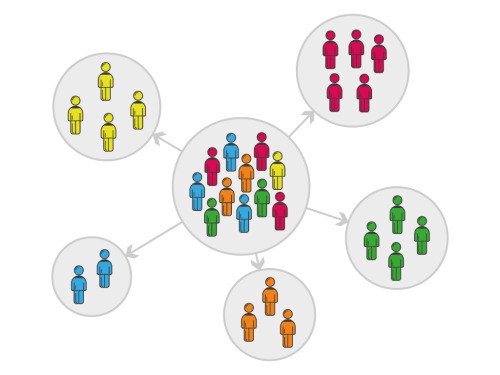
4 Common eCommerce Email Segmentation Mistakes to Avoid
Segmentation is a complex process, hence you’re prone to mistakes that can affect your entire email marketing strategy. While it’s important to have proven techniques, it’s also necessary to identify common mistakes you may encounter and how to avoid them.
1. Working with insufficient data
Segmentation thrives on real-time, accurate, and relevant data. Knowing your customer’s name and email address alone is insufficient to create an email segment. Additionally, having the wrong details is as good as having no data.
So, as much as you try to collect the necessary information, you should also clean your data regularly to improve accuracy and consistency.
2. Solely relying on past behavior
As shared earlier, customers’ needs change constantly, so having static segments may impair your email personalization. Using customers’ past behavior can help you predict possible future outcomes. However, this is not always the case, as buyers’ interests and preferences change over time.
For example, customers may decide to switch brands or change location. Understanding these changes is key to creating more personalized experiences with real-time data.
3. Not aligning segmentation with business goals
Every marketing strategy you employ should always align with your business goals. Creating segments without factoring your brand objectives complicates your overall marketing, as it can lead to missed opportunities. Even more, it would be difficult to track your progress over time.
For example, if your primary goal is to increase your CTR, you can create segments based on email engagement – email opens and click-throughs.
4. Segmenting based on intuition
Creating email segments based on your instincts or assumption can impair your personalization strategy. For example, people may abandon their carts for several reasons – low budgets, external distractions, or a change of interests.
If you create your segments assuming all individuals abandoned their carts due to low budget, you may be ignoring those who have changed preferences or left due to other reasons. So, data-driven segments not only improve your personalization but also help you identify changes in customer behavior.
Read also: eCommerce Email Marketing Simplified: 15 Examples + Tips
Wrap Up
Segmentation is a powerful technique for creating successful email marketing campaigns. However, it is nearly impossible to create smart segments at scale manually. This is because it’s challenging to track every customer’s behavior and interaction with your email. And even when you do this, you increase the chances of producing inaccurate or inconsistent data.
So, it’s crucial to start using a good marketing automation tool for streamlining the data collection process, creating custom filters, and segmenting your audience based on pre-defined attributes. You can achieve all of these and more with EngageBay, the all-in-one CRM software for marketing, sales, and service teams.
EngageBay provides real-time customer data, giving you updated insights into your shoppers’ recent actions, locations, and preferences.
Frequently Asked Questions
Can I automate email segmentation?
Yes, you can automatically group your audience into defined segments using email marketing tools. These tools use automated workflows and predefined rules to segment your customers using their demographic, behavioral, geographic, or psychographic data.
How many segments can I create?
The number of email segments you create depends on your business goals and marketing strategy. Ideally, you should only create segments you’re able to manage because you’d have to create multiple variations of emails for each group. So, you can preserve your marketing budget by only creating segments that will improve your overall marketing performance.
How do I get started with email segmentation?
You can get started with email segmentation by following these steps
- Define your goals and objectives
- Collect and analyze your data
- Identify your segmentation criteria/attributes
- Create your segments
- Test and refine your segments
How can I test and measure the success of my email segmentation strategy?
You can start by defining your goals and the metrics you want to track. The metrics may include open rate, conversion rate, overall ROI, revenue per email, unsubscribe rate, etc. This data can help you identify loopholes in your segments and areas that need adjustment.
